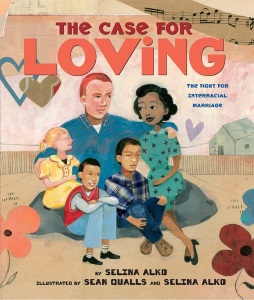Review of The Case for Loving: The Fight for Interracial Marriage
The Case for Loving: The Fight for Interracial Marriage
by Selina Alko; illus.
 The Case for Loving: The Fight for Interracial Marriage
The Case for Loving: The Fight for Interracial Marriageby Selina Alko; illus. by Sean Qualls and Selina Alko
Primary Levine/Scholastic 32 pp.
1/15 978-0-545-47853-3 $18.99
The 1967 Supreme Court case that legalized interracial marriage throughout the country is here given a picture-book accounting. Richard Loving was white, Mildred Jeter’s skin was a “creamy caramel”; despite their different racial backgrounds, they fell in love and married, only to be arrested for miscegenation when they returned to their Virginia hometown after the wedding. It’s a story about adults and with potentially much legalese, but Alko does a mostly admirable job of shaping the love story and the legal proceedings for a young audience. There is, however, a haziness about skin color and racial identity throughout the book that can be unclear, with lyrical references to “people of every shade” bumping confusingly with “colored,” and “black”; meanwhile, the term “interracial marriage” is used but not defined. While the book is honest about the obstacles the Lovings faced, its message and tone are optimistic, the feel-good atmosphere reinforced by the pencil, paint, and collage illustrations by Alko and Qualls (themselves partners in an interracial marriage). With soft, worn shades providing a gently old-timey aura, even a scene like the police busting in on the sleeping couple is sufficiently dramatic without being frightening. Frequent festoons of hearts and flowers, nice but overly decorative, help, too. Sources and a suggested reading list are appended.
From the May/June 2015 issue of The Horn Book Magazine.
RELATED
RECOMMENDED
ALREADY A SUBSCRIBER? LOG IN
We are currently offering this content for free. Sign up now to activate your personal profile, where you can save articles for future viewing.







Add Comment :-
Comment Policy:
Comment should not be empty !!!
Debbie Reese
Hi Roger, Thanks. Digging into that case was unendingly fascinating as I worked on my post. Re my question about terms used in the HB review, I think my confusion is because we're looking at two different pages. You noted what you read on the page that says: "Richard was white: a fair-skinned boy who got quickly sunburned in July. Mildred was what they called "colored" in those days: her skin a creamy caramel" And I was looking at the page that says: "Richard was a good, caring man; he didn't see differences. There was one person Richard loved more than the rest. Mildred Jeter was part African-American, part Cherokee..."Posted : Jun 18, 2015 04:56
Roger Sutton
I guess I don't understand the question. I identify the two protagonists by their different colors as stated by the text. But I did find your blog post about the book fascinating.Posted : Jun 18, 2015 01:48
Debbie Reese
Curious. The review says Loving was white but doesn't say anything about Jeter other than her skin color. Roger--what was the reason for that? The book says "part African-American, part Cherokee." For those interested in knowing more about her identity, I did a detailed post about it: http://americanindiansinchildrensliterature.blogspot.com/2015/03/the-case-for-loving-by-selina-alko-and.htmlPosted : Jun 17, 2015 03:58